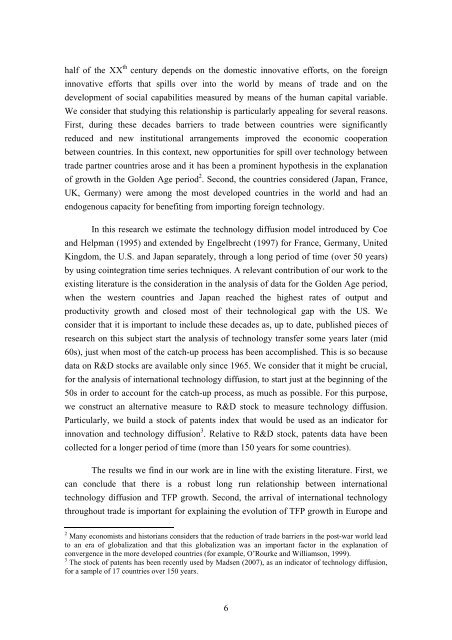You also want an ePaper? Increase the reach of your titles
YUMPU automatically turns print PDFs into web optimized ePapers that Google loves.
half of the XX th century depends on the domestic innovative efforts, on the foreign<br />
innovative efforts that spills over into the world by means of trade and on the<br />
development of social capabilities measured by means of the human capital variable.<br />
We consider that studying this relationship is particularly appealing for several reasons.<br />
First, during these decades barriers to trade between countries were significantly<br />
reduced and new institutional arrangements improved the economic cooperation<br />
between countries. In this context, new opportunities for spill over technology between<br />
trade partner countries arose and it has been a prominent hypothesis in the explanation<br />
of growth in the Golden Age period 2 . Second, the countries considered (Japan, France,<br />
UK, Germany) were among the most developed countries in the world and had an<br />
endogenous capacity for benefiting from importing foreign technology.<br />
In this research we estimate the technology diffusion model introduced by Coe<br />
and Helpman (1995) and extended by Engelbrecht (1997) for France, Germany, United<br />
Kingdom, the U.S. and Japan separately, through a long period of time (over 50 years)<br />
by using cointegration time series techniques. A relevant contribution of our work to the<br />
existing literature is the consideration in the analysis of data for the Golden Age period,<br />
when the western countries and Japan reached the highest rates of output and<br />
productivity growth and closed most of their technological gap with the US. We<br />
consider that it is important to include these decades as, up to date, published pieces of<br />
research on this subject start the analysis of technology transfer some years later (mid<br />
60s), just when most of the catch-up process has been accomplished. This is so because<br />
data on R&D stocks are available only since 1965. We consider that it might be crucial,<br />
for the analysis of international technology diffusion, to start just at the beginning of the<br />
50s in order to account for the catch-up process, as much as possible. For this purpose,<br />
we construct an alternative measure to R&D stock to measure technology diffusion.<br />
Particularly, we build a stock of patents index that would be used as an indicator for<br />
innovation and technology diffusion 3 . Relative to R&D stock, patents data have been<br />
collected for a longer period of time (more than 150 years for some countries).<br />
The results we find in our work are in line with the existing literature. First, we<br />
can conclude that there is a robust long run relationship between international<br />
technology diffusion and TFP growth. Second, the arrival of international technology<br />
throughout trade is important for explaining the evolution of TFP growth in Europe and<br />
2 Many economists and historians considers that the reduction of trade barriers in the post-war world lead<br />
to an era of globalization and that this globalization was an important factor in the explanation of<br />
convergence in the more developed countries (for example, O’Rourke and Williamson, 1999).<br />
3 The stock of patents has been recently used by Madsen (2007), as an indicator of technology diffusion,<br />
for a sample of 17 countries over 150 years.<br />
6

















